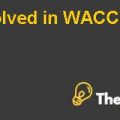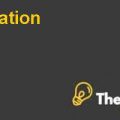
As per the requirement we use quarterly financial statement accounts for Microsoft Corporation to find the Free Cash Flow of the firm after making the forecasted financial statements from 2012 to 2014. While forecasting the financial statement for the next five years we made some assumptions. For the revenue calculation we took the average of growth rate of the revenue from the 20 quarterly financial statements of last five years which was around 4%. As we need to follow the percentage of sales approach, due to which we use most of the assumptions as percentage of sales for calculating balance sheet and income statement items. We carry forwarded some items that were not linked to the sales and we assumed that long-term debt and shareholders equity will remain constant.
Income statement items that were linked to sales, we took them as a percentage of sales for calculating the next quarterly values such as, Research and development expenses, Sales and marketing, General administrative and other expenses (income). We calculated the tax rate by dividing the tax expense of the previous month by taxable income and multiplied it with current taxable income. Non-continuing items assumed to be zero as their worth was zero in the previous quarters. Also, the cumulative effect of accounting change was zero in previous quarters, therefore, we carried forward that zero for the next quarters. As the company has never issued preferred stock, therefore, it would not distribute any prefer dividend in next quarters.
For the balance sheet, we took elements for the percentage of sale which include; short-term investments, inventories, accounts payable, accrued compensation. We calculated retained earnings as previous balance of retained earning plus additional balance of net income to shareholder equity after deducting the dividend payment we assumed that Microsoft would retain 74% of its earnings. We took 74% because in the second quarter of 2011, the company paid $0.2 dividend per share and we assumed it will continue to pay the same percentage of earnings in new quarter or years As its earnings per share were $0.78; therefore, it paid almost 26% of dividend in that quarter and assume to pay same percentage of dividends in next quarters. We carried forward some of the income statement items which were quite stable in some previous years such as deferred income tax that was $2,467, while goodwill was $12,581, intangible assets being $744, and $1,434 of other long-term assets. At Microsoft current liabilities are increasing faster than current assets except the cash and cash equivalence balance.
Liability side items which we carried forward were deferred income taxes, and long-term unearned revenue. We assumed that the company will keep its shareholder equity constant at $63,415 for the next 3 years with 8,382 of shares outstanding out of 24,000 authorized shares. Also, the company will keep the long term liability constant and will make repayments after the grace period of next 6-10 years. The company will raise the needed funds with short-term borrowing, when it will be short of funds but for next three years we assumed it to be constant. Therefore, we assumed the company’s capital structure will remain constant with 12% of debt and 88% of equity. The sustainable growth rate was around 47% with 63% of return on equity ratio multiplied by 74% of retention rate. Expected dividend per share from 2012 to 2014 will be $4.77, $7.37 and $8.56.
For Free cash flow valuations, we assumed the growth rate of 4%, which is the average of five years quarterly revenue forecast’s growth rate from 2008 to 2011. We took cost of capital for Microsoft from the market which was 12.52%. The income has been taken from the Performa financial statement which we calculated by taking some of the assumptions describe in above some paragraph. For 2012 to 2014 income was expected to be $39,970, $61,801 and $71,769 million and non-cash item was $2,766, $2,578 and $2,754 million. The changes in working capital were expected to be negative from 2012 to 2014 due to higher current assets. The capital expenditure was supposed to grow along with the percentage of sales and as you can see in the following figure it grows smoothly from $1,464 million in 2012 to 2,033 million in 2014. The free cash flow of the firm is initially ($186,707) million in 2012 because of larger amount of working capital requirements. After 2012, the FCFF gives positive values from 2013 to 2014 $65,745 and $75,584 million Microsoft Company would have PVFCFF of (60,947) million with present value of terminal free cash flows of $502,314 million and overall PVFCFF $441,367million,with 4% of growth rate and 12.52% cost of capital...............................
This is just a sample partial case solution. Please place the order on the website to order your own originally done case solution.












